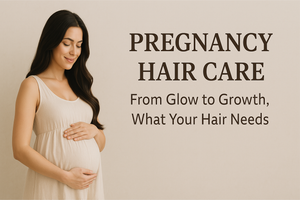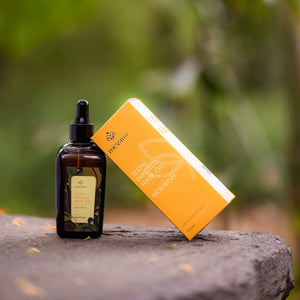How Do External Factors Impact Your Hair Health?
Have you ever had one of those mornings when you woke up with a tangled mess, wondering what happened to your once-pretty hair? And do you often wonder why your hair doesn't shine like it used to? Your diet is in check, your lifestyle is top-notch, and yet, you keep wondering where things go wrong.
But here's the plot twist: have you ever reflected that it could be the new city you've moved to for your dream job or to be with your love? Or it might be the changing weather or the water quality that affects your precious locks. Heck, it could even be the pollution taking a toll on your once-enviable hair.
Truth be told: all these external factors could be silently conspiring against your hair health, just like bad eating habits and lifestyle would! That's why we're here to uncover the often-overlooked culprits that could sabotage your hair health. Let's learn about these external factors and help transform your hair to its happy state!
The basics of hair health
Let's start with the basics.
- Your hair is mainly made of a protein called keratin, which gives it strength and structure.
- Every strand of your hair goes through three phases: growth, rest, and shedding. These determine how long and thick your hair grows.
- Your genes mostly decide your hair's thickness, texture, and growing tendencies. However, food, lifestyle, and environmental factors can also contribute!
The impact of external factors on hair health
Now that you know, genetics is like your fate. Still, your food, lifestyle, and environmental factors are the tools to change or improve that destiny. They all go hand in hand. No matter how healthy you eat or how good your lifestyle may be, it's all in vain if environmental factors take the best of you.
Even Ayurveda agrees on this aspect. It lists four external factors: air, water, land, and climate, which, when contaminated, can lead to adverse effects on your health. Your hair, an extension of your health, is not immune to these influences.
How bad air can result in bad hair?
Yes, the air you breathe can significantly affect the fate of your locks. Do you know how?

Culprit 1: Vehicular emissions and industrial pollutants
These contaminants in the air can settle on your hair, leading to a buildup that weakens it and makes it more prone to breakage and dullness!
Culprit 2: Particulate matter
Ever heard of particulate matter? These tiny particles in the air, often resulting from smoke and burning, can be a nightmare for your hair. They latch onto your strands, leading to increased dryness and reduced shine.
Culprit 3: Tobacco smoke
Tobacco smoke is a significant contributor to bad hair days, even if you are not the one smoking it! The chemicals in smoke damage not only your lungs but your hair as well, leaving it brittle and lackluster.
How does water quality affect your hair?
The seemingly harmless water flowing from your taps can also be a reason your hair health is affected.
Culprit 1: Hard Water
We all have heard of hard water (water with excessive minerals) and how it is unsuitable for our health. Little do you know that this type of water can be harsh on your hair, leaving behind a residue that makes it dull and frizzy.
Culprit 2: Chlorine
Chlorine is often added to water to kill harmful bacteria and pathogens. However, chlorinated water can strip hair of its natural oils, leaving it dry, brittle, and more prone to damage.
Culprit 3: Pollutants
Sometimes, the water flowing from our taps isn't as clean as it seems. Contaminated water can be a stealthy carrier of various pollutants, ranging from heavy metals like lead and copper to chemical residues from agricultural runoff. Heavy metals can strip away natural oils, leaving your hair dry and brittle. At the same time, chemical residues may contribute to dullness and increased dryness.
How can polluted land take a toll on your hair?
The place where you live and call your home may be another reason your hair is going bad.

source: the Hans India
Culprit 1: Contaminated Soil
When the soil is contaminated with pollutants, these substances may become airborne or attached to surfaces within the environment. As you move through areas with contaminated soil, these pollutants can settle onto your hair. Over time, these pollutants may accumulate, compromising your hair's health by stripping away natural oils, causing dryness, and making it more susceptible to damage.
Culprit 2: Agricultural Runoff
The lush fields you admire may also be contributing to your hair struggles. Agricultural runoff, laden with fertilizers and pesticides, can enter the landscape and, ultimately, your hair. The residues they leave behind can contribute to a cascade of hair issues, from increased dryness and frizz to a lifeless appearance.
Culprit 3: City Life
Urban areas' bustling activity can introduce pollutants like heavy metals and industrial emissions into the environment. Though invisible to the naked eye, these elements can find their way into hair, severely impacting it.
How does climate impact hair health?
Believe it or not, climatic conditions can severely impact your hair in ways you might not have imagined.
Culprit 1: Cold & Dry Climate
The cold winter air tends to be dry, sapping the moisture from your hair like a thief at night. The result? Hair that's more prone to dryness, frizz, and breakage.
Culprit 2: Hot & Humid Climate
With the mercury rising in summer, your scalp might become oilier and your hair more susceptible to damage. The combination of sweat and exposure to the harsh sun can lead to an oily scalp, making your hair feel heavy and less manageable.
Culprit 3: Rainy & Moist Climate
Rainy days mean excess moisture in the air, which could translate to frizz for your hair. The increased humidity can cause hair strands to swell and become unmanageable.
So, there you have it, the silent troublemakers around you who could be messing with your hair. Identified the stealthy culprit behind your bad hair days? Let us know in the comments. But go nowhere because we're not just stopping at identifying the issues. In the next part, we will dive into the right tools to equip you to triumph over these sneaky culprits. Stick around for more on everything about healthy hair!






